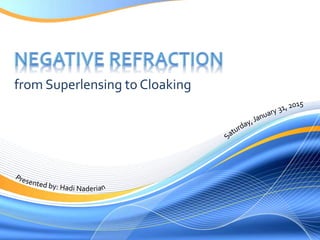
Negative Refraction
- 1. from Superlensing to Cloaking
- 2. Background Metamaterials Diffraction Superlens Cloaking Conclusion 2
- 3. Almost 40 years ago,Victor Veselago proposed the idea, It could make light waves appear to flow backward and behave in many other counterintuitive ways, Veselago failed to find anything having the electromagnetic properties he sought, Pendry, in the mid-1990s, material could gain its electromagnetic properties from tiny structures, In 2000 Smith, found a combination of metamaterials that provided the exclusive property of negative refraction. 3
- 4. Chemistry is not the only path to developing materials with an interesting electromagnetic response. Engineer electromagnetic response by creating tiny but macroscopic structures. The refractive index is Veselago showed that if ε and μ are both negative, then n must also take the negative sign. rrn 4
- 5. The key to producing a metamaterial is to create an artificial response to electric and magnetic fields. In an ordinary material A magnetic field ( purple) induces circular motion of electrons. An electric field ( green) induces linear motion of electrons ( red). 5
- 6. In a metamaterial Linear currents ( red arrows) flow in arrays of wires. Circular currents flow in split-ring resonators (SRRs). 6
- 7. A metamaterial is made by creating an array of wires and SRRs that are smaller than the wavelength of the electromagnetic waves to be used with the material. 7
- 8. 8
- 9. 9
- 10. In a negative-index material, the group and phase velocities are in opposite directions. Wavepacket moving from vacuum into glass with n=1.5 Wavepacket moving from vacuum into a NIM W.J. Schaich, Indiania 10
- 11. Places the ultimate limit on all imaging systems. Also determines the smallest feature that can be created by optical lithography processes. limits the amount of information that can be optically stored on DVD. 11
- 12. A rectangular slab of negative-index material forms a superlens. For some metamaterials, the image even includes details finer than the wavelength of light used, which is impossible with positive-index lenses. 12
- 13. Limited by the quality of its negative-index material. The best performance requires not just that the refractive index n = –1, but that both μ = –1 and ε = –1. In 2004, Anthony Grbic et.al showed experimentally that a metamaterial designed to have ε = –1 and μ = –1 at radio frequencies could indeed resolve objects at a scale smaller than the diffraction limit. When the distance between the object and the image is much smaller than the wavelength, we need only fulfill the condition ε = –1. 13
- 14. Optically without a superlens Optically with a 35- nanometer layer of silver in place Scale bar is 2,000 nanometers long 365-nanometer wavelength of the light used A focused ion beam 14
- 15. Pendry proposed to build a special material that wraps around an object and which would 'grab' light heading towards it and make it flow smoothly around the object rather than strike it. To an observer the light would appear to have behaved as if there was nothing there. 15
- 16. Conceal an object in the sphere r<R1 by bending all rays around it Transformation optics: blow up the origin to a sphere of radius R1 push the fields in r<R2 into R1<r<R2 16
- 17. A perfect cloak - keeps external radiation out, and internal radiation inside the cloak - works for any incident wave field - cloaks the object in near and far field - leaves no imprint on the phase of scattered light Min Qiu, KTH Stockholm 17
- 18. 1. Negative and : transparent, left- handed plane waves 2. Negative refraction 3. Perfect lens Microscopy, lithography 4. Transformation optics Perfect cloaking 5. Perfect lenses & cloaks: near-field, resonant phenomena 18